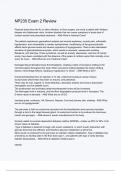NP235 Exam 2 Review
Physical stress from the flu or other infection, or from surgery, can send a patient with Addison
disease into Addisonian crisis. Another situation that can cause symptoms of acute lack of
cortisol results from prescribed treatment. - ANS-What is Adrenal Crisis?
The patient experiences generalized malaise and muscle weakness, muscle pain, orthostatic
hypotension, and vulnerability to cardiac dysrhythmias. Insufficiency of the glucocorticoids
affects blood glucose levels and causes symptoms of hypoglycemia. There is also decreased
secretion of gastrointestinal enzymes, which results in anorexia, nausea and vomiting,
flatulence, and diarrhea. These symptoms, as well as anxiety, depression, and loss of mental
acuity, have been correlated with the absence of the peaks of cortisol output that normally occur
every 24 hours. - ANS-What are s/s of adrenal crisis?
Damaged tissue liberates tissue thromboplastin, creating a state of excessive clotting in the
microcirculation throughout the body. When excessive clotting depletes the body's clotting
factors, hemorrhage follows, leading to hypotension or shock. - ANS-What is DIC?
Continued bleeding from an injection or IV site, extensive bruising in areas of injury,
ecchymoses where there has been no trauma, and petechiae.
There may be oral, vaginal, or rectal bleeding. Laboratory studies will reveal a decreased
hemoglobin and low platelet count.
The prothrombin and activated partial thromboplastin times will be increased.
The fibrinogen level is reduced, and the fibrin degradation products level is increased. The
D-dimer result is elevated. - ANS-What are s/s of DIC
Increase pulse, confusion, HA, Nervous, Nausea, Cool and clammy skin, shaking - ANS-What
are s/s of hypoglycemia?
The pancreas is both an endocrine (secretes into the bloodstream) and exocrine (secretes
through a duct to the target tissues) gland. Its endocrine function is to produce the hormones
insulin and glucagon. - ANS-where is insulin manufactured in the body
formerly called non-insulin-dependent diabetes mellitus (NIDDM)—makes up 90% to 95% of all
known cases of diabetes.
Type 2 diabetes is believed to begin with insulin resistance, in which insulin interaction with
glucose becomes less efficient, and therefore glucose metabolism is abnormal.
More insulin is produced by the pancreas to maintain cellular metabolism. Type 2 diabetes has
a tendency to develop later in life than does type 1, and patients with type 2 rarely develop
diabetic ketoacidosis. - ANS-What is diabetes mellitus type 2
obesity
, asian, hispanic, african american, American Indian
In type 2 diabetes there also seems to be a relationship to aging and a reduction in the function
of the pancreatic beta cells and how they synthesize insulin. - ANS-What are some risk factors
for DM type 2?
characterized by spasm of the arteries of the upper and lower extremities with an exaggerated
response to cold and stress, resulting in bilateral vasospasm. - ANS-Raynaud's disease
protect the extremities from cold, stress, vasoconstriction!
The patient should be taught to:
Dress warmly when in cold environments.
Clothing should be layered and nonrestrictive. Hat, gloves, and warm socks should be worn.
Wear protective gloves when reaching into ovens and when handling extremely cold items.
Avoid cold temperatures when possible, to manage stress, and to stop tobacco use. Caffeine
intake should be limited.
If appropriate, the patient should be referred to a smoking cessation program. - ANS-what
education would you provide to your patient to prevent complications of Raynauds disease
give to stroke pts.
they disolve clots.
at risk for hemorrage.
Anticoagulants work by preventing blood clots from forming. Some do this by preventing the
body from making clotting factors. Others keep the clotting factors from working or prevent other
chemicals from forming so that clots can't develop - ANS-What does a patient take
thrombolytics for
administration of oxygen, pain-relieving drugs, and oral and intravenous fluids to reduce pain
and prevent complications. Doctors also may recommend blood transfusions, folic acid
supplements, and antibiotics.
A bone marrow transplant may be an effective treatment in some circumstances - ANS-What is
the priority in treating sickle cell patients
Reduction of high blood pressure(2)
Long-term control to decrease the risk of stroke, heart attack, loss of vision, and kidney disease.
The target is to control blood pressure at or below 120/80 mm Hg.




